
The black currawong, also known locally as the black jay, is a large passerine bird endemic to Tasmania and the nearby islands within the Bass Strait. One of three currawong species in the genus Strepera, it is closely related to the butcherbirds and Australian magpie within the family Artamidae. It is a large crow-like bird, around 50 cm (20 in) long on average, with yellow irises, a heavy bill, and black plumage with white wing patches. The male and female are similar in appearance. Three subspecies are recognised, one of which, Strepera fuliginosa colei of King Island, is vulnerable to extinction.

The plain-brown woodcreeper, is a sub-oscine passerine bird which breeds in the tropical New World from Honduras through South America to northern Argentina, and in Trinidad and Tobago. Sometimes it is considered to include the plain-winged woodcreeper as a subspecies.
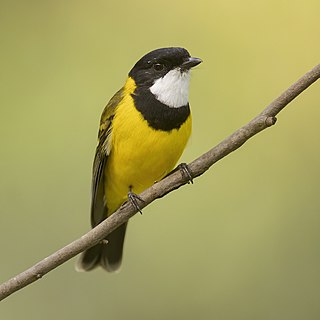
The Australian golden whistler or golden whistler, is a species of bird found in forest, woodland, mallee, mangrove and scrub in Australia Most populations are resident, but some in south-eastern Australia migrate north during the winter. Its taxonomy is highly complex and remains a matter of dispute, with some authorities including as many as 59 subspecies of the golden whistler, while others treat several of these as separate species.
The Polynesian storm petrel is a species of seabird in the family Oceanitidae. It is the only species placed in the genus Nesofregetta.
The forest swallow is a little-known species of swallow in the family Hirundinidae, found in Cameroon, Republic of the Congo, Equatorial Guinea, Gabon, and Nigeria. The species was previously placed in the genus Petrochelidon, within the ‘mud-nester’ clade of swallows, yet its plumage, morphology, and nesting behavior did not align well with those of other major swallow lineages. As a consequence, and also employing molecular phylogenetic approaches, De Silva et al. (2018) placed this species in the swallow phylogenetic tree, firmly within the ‘mud nester’ clade, but outside of the clade corresponding to Petrochelidon. This outcome led De Silva et al. (2018) to document and describe formally a distinct, generic-level lineage of swallow endemic to the Lower Guinean forest region of central Africa.
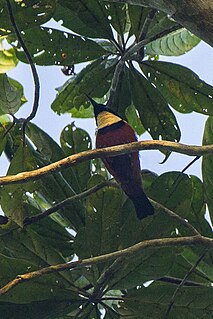
The buff-throated sunbird is a species of bird in the family Nectariniidae. It is found in Benin, Cameroon, Ivory Coast, Ghana, Guinea, Guinea-Bissau, Liberia, Nigeria, Sierra Leone, and Togo.

The amethyst sunbird, also called the black sunbird, is a species of passerine bird in the family Nectariniidae. It is native to the Afrotropics, mostly south of the equator. They are commonly found in well-watered habitats, and undertake seasonal movements to visit flowering woodlands. The demise of some woodlands have impacted their numbers locally, but their range has also expanded along with the spread of wooded gardens.
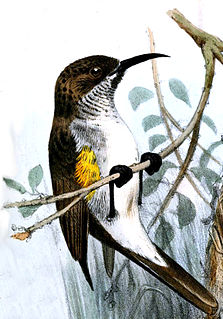
The Socotra sunbird is a species of bird in the family Nectariniidae. It is endemic to Socotra.
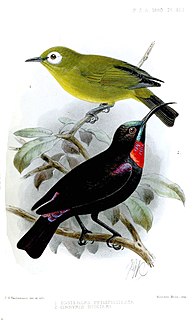
Hunter's sunbird is a species of bird in the family Nectariniidae. It is found in Ethiopia, Kenya, Somalia, South Sudan, Tanzania, and Uganda.

Neergaard's sunbird is a species of bird in the family Nectariniidae. It is found in Mozambique and South Africa. Its natural habitat is subtropical or tropical dry forest near the coast, where it is threatened by habitat loss. It is named after Paul Neergaard, a Danish recruiting officer for the Wenela agency, who was stationed in southern Mozambique.

The green-throated sunbird is a species of bird in the family Nectariniidae. It is found in Angola, Burundi, Cameroon, Central African Republic, Republic of the Congo, Democratic Republic of the Congo, Equatorial Guinea, Gabon, Kenya, Nigeria, Rwanda, South Sudan, Tanzania, Uganda, and Zambia.

The scarlet-chested sunbird is a species of bird in the family Nectariniidae.

The mountain saw-wing, also known as the mountain rough-winged swallow or the Cameroon Mountain rough-winged swallow is a species of bird in the family Hirundinidae.
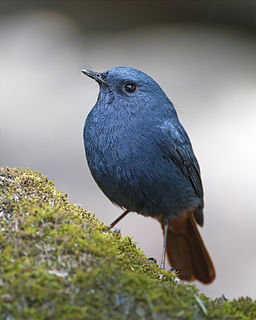
The plumbeous water redstart is a passerine bird in the Old World flycatcher family Muscicapidae. It is found in South Asia, Southeast Asia and China. Males are slate blue in colour, while females are grey. The bird's common name refers to its colour which resembles lead. They tend to live near fast-moving streams and rivers.

The white-chinned thistletail or colicardo barbiblanco is a species of bird in the family Furnariidae. It is found in Colombia, Ecuador, Peru, and Venezuela. Its natural habitats are subtropical or tropical moist montane forests and subtropical or tropical high-altitude grassland.

The sooty grassquit is a small bird. It is recognized as a tanager closely related to Darwins finches.
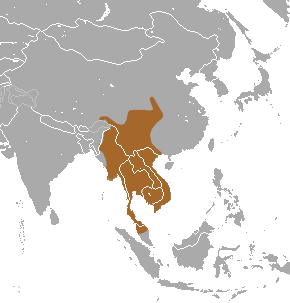
The Southeast Asian shrew is a species of mammal in the family Soricidae. It is found in Cambodia, India, China, Laos, Malaysia, Myanmar, Thailand, and Vietnam.

Heliaeschna fuliginosa is a species of dragonfly in the family Aeshnidae. It is found in Angola, Cameroon, Central African Republic, the Democratic Republic of the Congo, Ivory Coast, Equatorial Guinea, Gabon, Gambia, Ghana, Guinea, Liberia, Nigeria, Sierra Leone, and Uganda. Its natural habitat is subtropical or tropical moist lowland forests.

Chalcomitra is a genus of African sunbirds. Its members are sometimes included in Nectarinia.

The New Zealand fantail is a small insectivorous bird, the only species of fantail in New Zealand. It has four subspecies: R. f. fuliginosa in the South Island, R. f. placabilis in the North Island, R. f. penita in the Chatham Islands, and the now-extinct R. f. cervina formerly on Lord Howe Island. It is also known by its Māori names, pīwakawaka, tīwakawaka or piwaiwaka, and the Chatham Island subspecies by the Moriori name tchitake; the common pied morph is also known as pied fantail, and the uncommon dark morph is also known as black fantail. The species has been considered by many to be conspecific as the grey fantail of Australia and New Caledonia; however, due to significant differences in its calls, many authorities now treat it as a separate species.



















